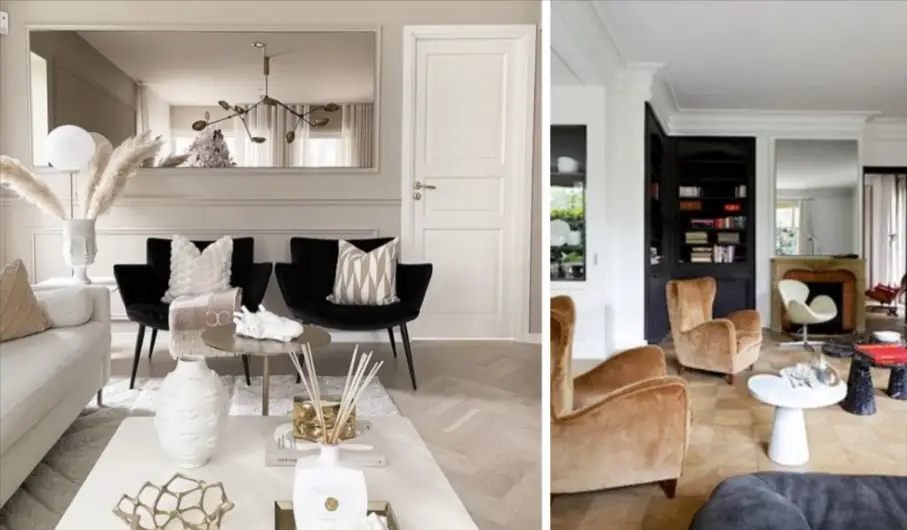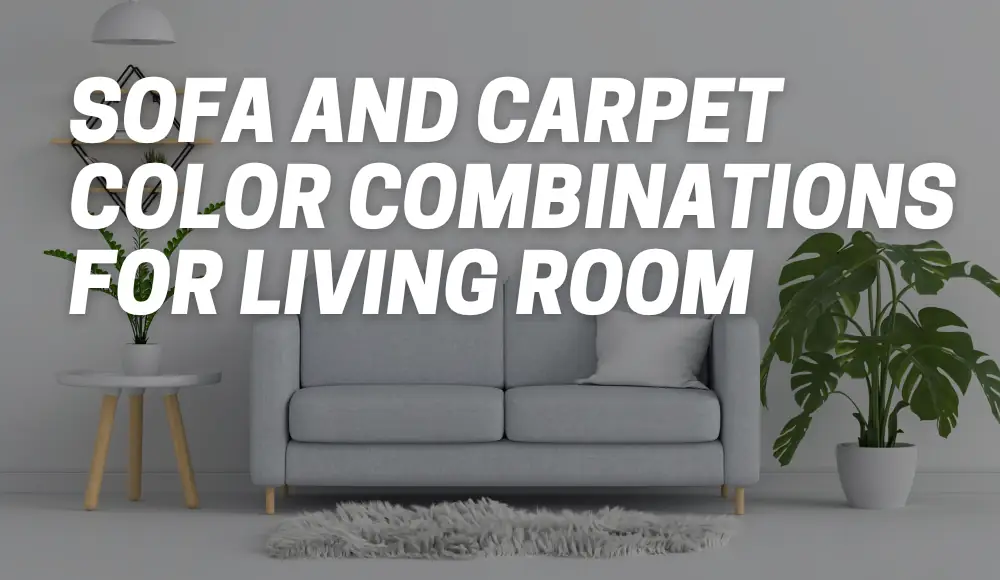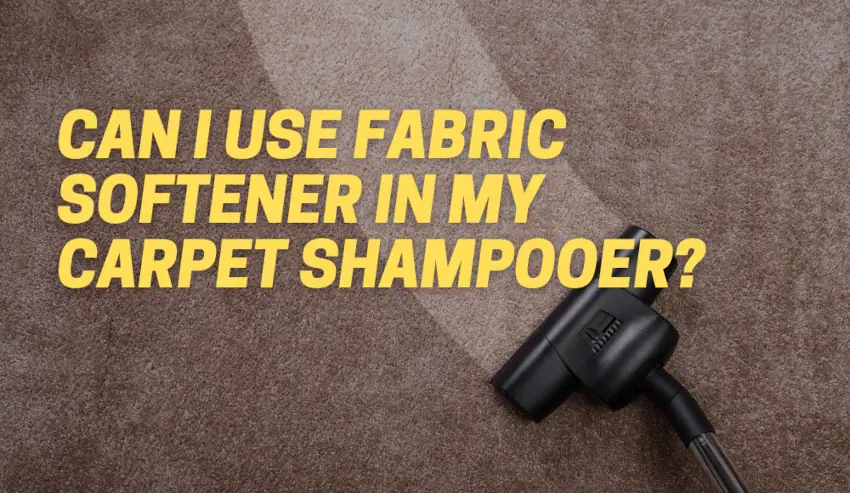Last updated on October 29th, 2023 at 02:33 am
When it comes to creating an inviting and stylish living room, one of the key elements you’ll want to consider is the combination of colors for your sofa and carpet. The right color combination can transform your living space, making it not only aesthetically pleasing but also comfortable and cozy. In this guide, we will explore various aspects of sofa and carpet color combinations, helping you make informed choices that will enhance your living room’s ambiance and overall design.
Popular Sofa and Carpet Color Combinations
Let’s start by discussing some of the most popular sofa and carpet color combinations for a living room. These combinations have stood the test of time and continue to be favored for their timeless appeal.
1. Neutral on Neutral
- Sofa: Choose a neutral-toned sofa, such as beige, gray, or cream.
- Carpet: Opt for a carpet in a similar neutral shade or a slightly lighter or darker tone.
This combination creates a calm and versatile backdrop for your living room. It’s easy to accessorize with vibrant pillows, artwork, or other decorative elements to add a pop of color.
2. Contrasting Colors
- Sofa: Go for a bold color like deep blue, rich red, or emerald green.
- Carpet: Select a neutral carpet in shades like gray, beige, or ivory.
Contrasting colors add drama and personality to your space. The vibrant sofa becomes a focal point against the neutral backdrop, creating a striking visual impact.
3. Tonal Harmony
- Sofa: Pick a sofa that is a shade or two lighter or darker than your carpet.
- Carpet: Choose a carpet that complements the sofa’s color with subtle variations.
Tonal harmony creates a cohesive and soothing atmosphere. It’s a great choice if you prefer a more understated look.
What Two Colours Go Well Together In a Living Room?
Choosing the right color combination for your living room can significantly impact the room’s overall ambiance and aesthetics.
Here are some classic and timeless two-color combinations that work well in a living room:
- Blue and White: This combination is a classic choice that exudes a sense of calm and freshness. Navy blue and white, in particular, create a nautical, coastal, or Hamptons-style look. Light blue and white can give your living room an airy and relaxed feel.
- Gray and Yellow: Gray is a versatile neutral that pairs beautifully with a pop of yellow. This combination adds sophistication and a touch of cheerfulness to your living space. It’s particularly effective in contemporary and modern designs.
- Beige and Red: Beige, as a neutral color, complements the vibrant and warm tones of red. This combination can create a cozy and inviting atmosphere. It works well in traditional and rustic living rooms.
- Green and Brown: The earthy tones of green and brown work together to bring the outdoors inside. This combination is perfect for creating a natural and relaxing environment. It suits rustic, country, or botanical-themed decor.
- Black and White: A monochromatic black and white scheme offers a timeless and sophisticated look. This high-contrast combination is suitable for modern and minimalist design, adding a sense of elegance to your living room.
- Gray and Teal: Gray serves as a neutral backdrop for the richness of teal. This pairing can create a balance between calm and vibrancy, making your living room feel both serene and lively. It’s ideal for contemporary or eclectic designs.
- Brown and Cream: Brown is a warm and earthy color that pairs harmoniously with cream. This combination creates a cozy and inviting atmosphere, making it well-suited for traditional and cottage-style living rooms.
- Purple and Gray: The regal hue of purple paired with the neutrality of gray can bring a sense of luxury and sophistication to your living space. It’s a unique and stylish choice that works well in contemporary or eclectic interiors.
It’s essential to consider factors like the room’s lighting, your personal preferences, and the existing decor when selecting the perfect color combination for your living room. Additionally, adding accents and accessories in complementary colors can further enhance the visual appeal of your space.
Should a Sofa Be Lighter or Darker Than the Carpet?
The choice between a lighter or darker sofa compared to the carpet often depends on the effect you want to achieve. If you’re aiming for a more spacious and open feel in your living room, a lighter sofa can help.
- Lighter colors tend to make a room appear larger and airier.
- On the other hand, a darker sofa can add warmth and coziness, making the room feel more intimate.

The Best Color Combination for a Living Room: Top 10 Colors
The best color combination for your living room ultimately depends on your personal preferences and the existing decor. However, some universally loved colors for living rooms include:
- Light Gray and Soft Blue
- Navy Blue and Crisp White
- Beige and Teal
- Olive Green and Earth Tones
- Burgundy and Gold
- Cream and Charcoal
- Mustard Yellow and Gray
- Muted Pink and Neutral Tones
- Charcoal Gray and Muted Red
- Emerald Green and Beige
These color combinations are not only visually appealing but also versatile, allowing you to adapt and change your decor as desired.
Cream and Charcoal living room

What Color Sofa Makes a Room Look Bigger?
If you’re working with a smaller living room and want to create the illusion of more space, consider opting for a light-colored sofa. Shades like light gray, soft beige, or pale blue can reflect light and make the room appear larger.
A sofa’s color can have a significant impact on how a room appears in terms of size and spaciousness. If you want to make a room look bigger, consider the following sofa colors and strategies:
- Light Neutrals: Light neutral colors, such as soft beige, pale gray, and off-white, are excellent choices for making a room appear more spacious. These colors reflect light, creating a sense of openness and airiness. Light neutrals also provide a versatile backdrop for other elements in the room, allowing for easy coordination with decor and accessories.
- Cool Tones: Cool colors like light blues and soft greens can also create an illusion of more space. These colors have a calming effect and can make a room feel more expansive. They work particularly well in bedrooms and living rooms where a tranquil atmosphere is desired.
- Pastels: Pastel shades, including light pinks, lavenders, and mint greens, have a similar effect to cool colors. They add a sense of lightness and can make a small room feel more open and inviting.
- Gray: Light gray, when used correctly, can give the impression of a larger room. It serves as a neutral canvas for other decor elements and can be paired with a range of accent colors for a dynamic look.
- Mirror Accents: Consider adding mirrored elements to your room, such as mirrored furniture or decorative mirrors on the walls. Mirrors reflect light and create the illusion of more space, regardless of your sofa’s color.
- Raise the Sofa: Opt for a sofa with visible legs or choose a leggy style. This design choice allows more of the floor to be visible, making the room feel less crowded and more spacious.
- Keep it Simple: Choose a sofa with a simple, streamlined design. Avoid overly bulky or ornate furniture, as it can visually shrink the room. Clean lines and minimalistic designs work well in smaller spaces.
- Monochromatic Schemes: Consider using a monochromatic color scheme, where the sofa’s color is similar to the wall color. This creates a seamless look and removes visual boundaries, making the room appear larger.
- Use Vertical Lines: Vertical stripes or patterns in the sofa fabric can draw the eye upward, giving the impression of higher ceilings and a larger room. Vertical lines also create a sense of movement and openness.
- Multi-Functional Furniture: Invest in multi-functional furniture pieces, such as a sofa bed or a storage ottoman, to reduce clutter and make the room feel more organized and spacious.
Consider the overall design, layout, and lighting of the space to maximize the effect. Light, neutral, and cool colors, along with the use of mirrors and strategic design choices, can help create a sense of openness and spaciousness in a room, regardless of its actual size.
Should Carpet Match Walls or Furniture?
Matching the carpet to the walls can create a cohesive and harmonious look. This approach tends to work well in rooms where you want a unified and tranquil ambiance. However, it’s important to introduce variety and contrast through other elements, such as furniture and decor, to prevent the space from feeling monotonous.
- Matching Carpet and Walls:
- Cohesive and Serene Look: When your carpet matches the color of your walls, it creates a sense of cohesion and tranquility. The seamless transition between the floor and the walls can make your space feel more harmonious and less visually fragmented.
- Space Enhancement: This approach can make your room appear more extensive, especially if you use a light or neutral color palette. The lack of strong visual contrast between the floor and walls creates an uninterrupted expanse that can make the room feel larger.
- Versatility: A matching carpet and wall color scheme is highly versatile and serves as an excellent backdrop for various styles and color accents in your furniture, decor, and accessories.
- Matching Carpet and Furniture:
- Color Harmony: When you choose a carpet color that complements your furniture, it can create a harmonious and balanced color scheme. This approach allows you to work with different wall colors while maintaining a sense of unity in your room.
- Focal Point Emphasis: If your furniture or decor items are the highlights of your room’s design, matching the carpet to them can help accentuate these focal points. The carpet acts as a neutral base that allows your furniture to shine.
- Personal Style Expression: Coordinating your carpet with your furniture offers the opportunity to express your personal style and preferences. You can play with various color combinations and design themes that reflect your taste.
Keep in mind that it’s not an all-or-nothing choice; you can find a balance between these elements. For example, you can match your carpet to the walls while using colorful furniture and decor items to create visual interest and contrast.
Choosing the Right Carpet Color to Match Your Sofa
Selecting the right carpet color to complement your sofa involves several factors to consider:
- Lighting: Take into account the natural and artificial lighting in the room. Dark carpets can absorb light and make the room feel cozier, while light carpets can brighten the space.
- Sofa Color: Consider the undertones in your sofa’s color. If your sofa has warm undertones, opt for a carpet with similar warm undertones.
- Room Style: The overall style of your living room, whether it’s contemporary, traditional, or eclectic, will influence your choice of colors.
- Personal Preferences: Ultimately, your personal taste and the ambiance you want to create should guide your decisions.
Modern Sofa and Carpet Color Combinations
Staying up-to-date with modern design trends is a great way to ensure your living room looks fresh and stylish. Here are some modern sofa and carpet color combinations to consider:
1. Earthy Neutrals
- Sofa: Earthy tones like terracotta or sage green.
- Carpet: A neutral, textured carpet in gray or beige.
This combination brings a touch of nature indoors, creating a serene and inviting atmosphere.
2. Monochromatic Elegance
- Sofa: Choose a sofa and carpet in varying shades of the same color, such as various shades of blue or gray.
Monochromatic palettes exude sophistication and are a hallmark of modern design.
3. Bold Pops of Color
- Sofa: A vibrant sofa in a bold color.
- Carpet: A more neutral carpet that allows the sofa to take center stage.
This approach is perfect for those who love a contemporary and playful look.
Mixing Patterns and Colors
Mixing patterns and colors in the same room can be exciting and visually appealing if done thoughtfully. Here are some principles to follow:
- Scale: Vary the scale of patterns. Pair a large-scale patterned carpet with a smaller-scale patterned sofa or vice versa.
- Color Harmony: Ensure that the colors in both the sofa and carpet relate to each other in some way, either through complementary or analogous colors.
- Neutral Anchor: Use a neutral element, such as a neutral-toned wall or furniture, to balance out the bold patterns.
- Consistency: Maintain a consistent color palette throughout the room to tie everything together.
Using a Neutral Sofa with a Colorful Carpet
If you have a neutral sofa and want to introduce vibrancy with a colorful carpet, there are several ways to achieve a harmonious look:
- Pillows and Throws: Add colorful throw pillows and blankets to your neutral sofa to infuse vibrant accents.
- Wall Paint: Consider painting one wall in a coordinating color that complements the colorful carpet.
- Artwork and Decor: Use colorful artwork and decorative items that echo the hues of the carpet.
This combination allows you to add pops of color while maintaining the versatility of a neutral sofa.
Colors to Avoid
While there are no hard and fast rules when it comes to interior design, there are some color combinations that may clash or create an unbalanced look. For instance, pairing clashing colors like red and green can be visually jarring.
Here are some color combinations to consider avoiding in your living room:
- Red and Green: This combination can evoke strong associations with Christmas, which might not be the desired year-round aesthetic. It can also be visually intense when used in equal proportions.
- Bright Red and Bright Yellow: These two bold, primary colors can create a visually jarring and overstimulating environment. It’s a combination that’s generally too intense for most living rooms.
- Brown and Gray: Brown and gray can work well together when used thoughtfully, but combining two neutrals with similar undertones can result in a lack of contrast and visual interest. It’s best to introduce other colors or textures to balance this combination.
- Red and Purple: These two strong, contrasting colors can create a chaotic and overwhelming atmosphere. The combination can be challenging to work with and may feel too intense.
- Too Many Strong Neutrals: Using an excess of neutral colors, especially if they are all very similar in tone, can result in a bland and unexciting room. It’s important to introduce some contrast or accent colors to enliven the space.
- Orange and Black: While orange can be a warm and inviting color, when paired with black, it can create a Halloween-inspired look that might not be suitable for a year-round living room design.
- Clashing Complementary Colors: Complementary colors, such as red and green or blue and orange, are opposite on the color wheel and can create a strong visual contrast. While this can be striking, it can also be challenging to balance. Using these combinations sparingly and thoughtfully is key.
- Too Much Dark and Saturated Color: Using an abundance of dark and highly saturated colors can make a room feel oppressive and heavy. It’s important to balance these with lighter or neutral tones to avoid an overly intense atmosphere.
- Distracting Patterns with Bold Colors: Combining busy, bold patterns with equally bold colors can result in a chaotic and visually overwhelming space. It’s best to use patterns and bold colors sparingly or to ensure they complement each other.
- Mismatched Undertones: When selecting colors, consider the undertones in the paint or furnishings. Combining cool undertones with warm undertones can create a disjointed and unbalanced look. It’s essential to choose colors with similar undertones for a more harmonious space.
The key is to consider the overall mood and atmosphere you want to create in your living room and to choose colors that align with your design goals and personal style. It’s also a good idea to use color samples and swatches to test combinations before making a final decision.
Coordinating with Other Room Decor
Coordinating the colors of your sofa and carpet with the rest of your room’s decor is crucial for achieving a harmonious and polished look. Here are some insights on how to achieve a cohesive living room design:
- Wall Paint: Consider how the wall color complements your sofa and carpet. If you have a colorful sofa and carpet, a neutral wall color can help balance the room. Conversely, if your sofa and carpet are neutral, you have more flexibility to experiment with bolder wall colors.
- Curtains and Drapes: Your choice of window treatments can play a significant role in the overall look. Coordinating the curtain color with the sofa or carpet color can tie the room together.
- Decorative Accessories: Use decorative items like cushions, vases, and artwork to introduce color accents that echo the hues of your sofa and carpet. This adds a sense of unity to the room.
- Lighting: The color temperature of your lighting can affect how colors appear in your living room. Warm lighting can enhance the cozy feel of a room, while cooler lighting can make colors appear crisper.
- Furniture: If you have other pieces of furniture in the living room, ensure that their colors complement or contrast effectively with the sofa and carpet.
Impact of Color Combinations on Perception
Different color combinations can have a profound impact on the perception of room size and mood. Understanding these effects can help you achieve your desired ambiance:
- Light Colors: Light and neutral colors make a room feel more open and spacious. They also tend to create a calm and airy atmosphere.
- Dark Colors: Darker colors add coziness and intimacy to a room. They can make large spaces feel more inviting but may also make a small room appear even smaller.
- Cool Colors: Blues and greens create a soothing and tranquil environment, perfect for relaxation.
- Warm Colors: Reds, oranges, and yellows are energizing and can create a vibrant and lively atmosphere.
- Contrasting Colors: Contrasting colors, like a bold sofa against a neutral carpet, can add drama and visual interest to the room.
Carpet Materials and Sofa Colors
The material of your carpet can also play a role in the overall look of your living room. Different carpet materials have distinct characteristics:
- Wool: Wool carpets are durable, soft, and come in a wide range of colors. They work well with a variety of sofa colors and styles.
- Synthetic: Synthetic carpets, such as nylon or polyester, are often more budget-friendly and come in vibrant colors. They can be an excellent choice for colorful and family-friendly living rooms.
- Natural Fibers: Natural fiber carpets like jute or sisal have a textured and organic look. They are best paired with neutral and earthy sofa colors for a harmonious natural feel.
Using Color Psychology
Color psychology can be a powerful tool for creating the desired ambiance in your living room. Here are some color associations and how you can use them:
- Blue: Calming and serene, blue is perfect for creating a peaceful atmosphere. Use it in coastal or contemporary designs.
- Red: Energizing and stimulating, red is ideal for creating a vibrant and lively space. It works well in eclectic or modern interiors.
- Green: Associated with nature, green can create a tranquil and fresh ambiance. It’s great for creating a relaxing atmosphere in traditional or bohemian spaces.
- Yellow: Cheerful and optimistic, yellow can add warmth and positivity to your room. It complements traditional or farmhouse designs.
- Gray: Versatile and elegant, gray is a neutral choice that can work well with almost any decor style. It creates a timeless and sophisticated look.
Can a Sofa Be the Same Color as the Carpet?
While having a sofa and carpet in the same color is possible, it may not always be the most visually interesting choice. It can create a monochromatic and subdued look.
To make it work, consider adding texture and pattern through accessories, such as throw pillows, to break up the uniformity and add depth to the room. Here are some advantages and considerations for having a sofa and carpet of the same color:
Advantages:
- Cohesion: When the sofa and the carpet are the same color, it creates a sense of visual cohesion. This consistency can give your living room a polished and harmonious appearance.
- Simplicity: A monochromatic color scheme simplifies the design process. It makes it easier to choose other decor elements, such as throw pillows, curtains, and artwork, as they can coordinate seamlessly with the sofa and carpet.
- Room Enlargement: Using the same color for both the sofa and carpet can visually expand the room. The consistent color scheme eliminates visual boundaries, making the space appear larger and more open.
- Timelessness: Monochromatic color schemes tend to be timeless and versatile. They can work with a variety of design styles and adapt to changing decor trends.
Considerations:
- Texture and Pattern: To avoid a monotonous look, consider introducing texture and pattern variation. You can do this through the use of throw pillows, area rugs, or other decor elements.
- Maintaining Cleanliness: A single color can reveal stains or wear more prominently. If you have a family or pets, you might need to be more vigilant about keeping the sofa and carpet clean.
- Accent Colors: While a same-color sofa and carpet are consistent, you may want to introduce accent colors to add vibrancy and interest to the room. This can be achieved through colorful accessories, artwork, or other pieces of furniture.
- Room Size: Monochromatic color schemes can be especially effective in smaller spaces to create a sense of spaciousness. In larger rooms, you may need to balance the single color with accents to prevent it from feeling monotonous.
Both options can be successful, so it’s a matter of your design preferences and the overall aesthetic you want to achieve.
Online Services for Color Palettes
If you’re uncertain about the color combinations or want to experiment with different palettes, there are online tools and services available to help. These tools allow you to generate color palettes for your living room:
- Adobe Color Wheel: This tool helps you create color schemes based on color theory principles.
- Coolors: Coolors is a simple and intuitive color palette generator that lets you experiment with various color combinations.
- Canva Color Palette Generator: Canva offers a user-friendly color palette generator to help you find the perfect combination for your living room.
Conclusion
In conclusion, selecting the right sofa and carpet color combination for your living room is a creative process that involves considering various factors, including personal preferences, room size, decor style, and the desired ambiance.
By understanding the principles of color coordination and design, you can create a living space that reflects your unique style and makes a lasting impression on anyone who enters. Whether you opt for classic combinations or venture into more modern and eclectic choices, remember that your living room is a canvas for your creativity, and there are no rigid rules when it comes to personalizing your space.
So, let your imagination and personal style guide you in choosing the perfect color combination that will make your living room truly exceptional.


